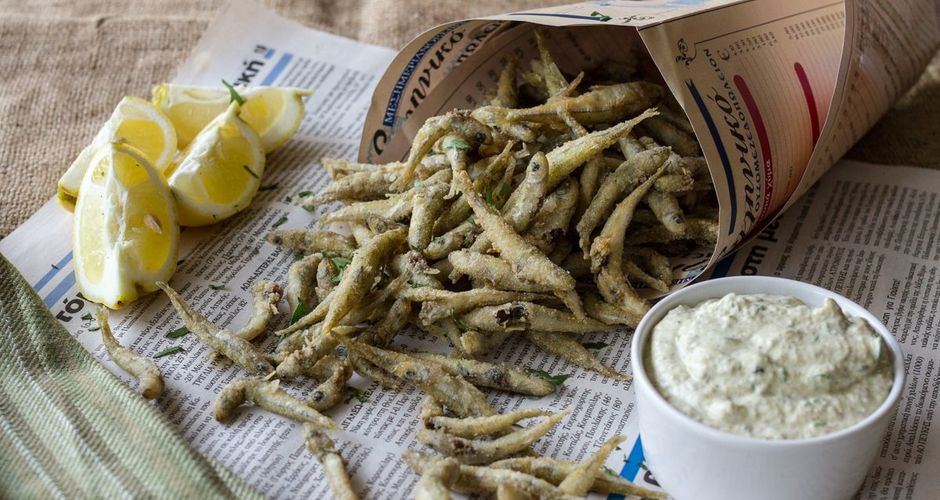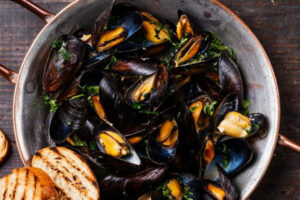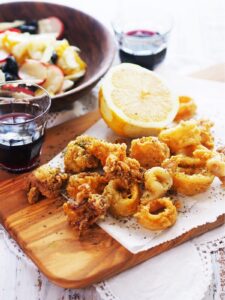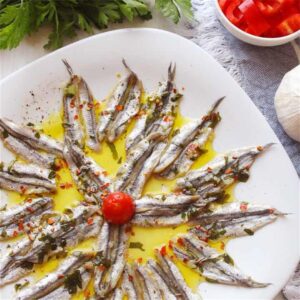Whether you find yourself at a Greek fish taverna (Psarotaverna) with knowledgeable local friends or totally unaccompanied by accommodating translators/explainers of mysterious-sounding things on the menu, it helps to have a decent knowledge of what you’re eating.
As a rule, the best fish tavernas and restaurants overall are those that have only the freshest dishes available – the more pages on the menu, the more you can be certain that half the foods are frozen and microwaved as opposed to whisked out of the fisherman’s bucket and cooked. Usually fish taverns and other Greek restaurants divulge whether a fish on their menu is fresh or frozen by including an asterisk next to the name of the said
fish, but it’s better to be gratified by fresh catch than have your senses dulled by something that’s edible but tastes blah. Here we offer you a guide to the most commonly found delights served up in fish taverns around the country.
Atherina
What it is: A tiny fish (sand smelt in English) that’s dipped in batter and deep fried to a delicious crispy consistency.
How it’s eaten: With your fork or, for the Boho-beach-carefree ones among you, with your hand, and entire. Some people chop off the heads due to psychological reasons (especially with the thicker, larger types of atherina fish) but really, it makes no difference to the overall taste. Served with a sprinkling of salt and squeeze of lemon.
Kalamarakia Tiganita
What it is: Calamari that is cut into rings and tentacles, dipped in batter and deep fried to a crisp. When cooked properly the calamari will be only very slightly chewy and not at all rubbery. It will have an almost creamy consistency when masticated that mixes perfectly with the crunch of its batter.
How it’s eaten: With a sprinkling of salt and lemon, using a fork and often very fast as this is one of the most popular fish tavern delights.
Kalamari Stin Schara
What it is: Calamari cooked on the grill with a little olive oil and salt, usually half-sliced along its length. As with all calamari, the fish should not be too rubbery, although the grilled version is usually a little more al dente than the fried rendition.
How it’s eaten: With a squeeze of lemon.
Barbouni
What it is: Small to medium-sized Red Mullet that’s passed through flour before being pan-fried. The skin becomes crispy and the flesh should be juicy and tender.
How it’s eaten: First cut off the head. Next, be cut it open by slicing it across the middle and opening into two fillets. Remove the spine and bones, sprinkle with salt and lemon and enjoy.
Htapodi
What it is: Octopus, which is usually beaten to death on a rock upon being caught in order to soften its texture.
How it’s eaten: Most commonly the octopus tentacles are cooked on the grill and served with a drizzle of balsamic vinegar and salt, or it can be marinated with lemon and vinegar and in more recent years has become trendy in a carpaccio rendition.
Ahinosalata
What it is: Sea urchin eggs. The word ‘salata’ can be a little misleading as there is no lettuce (or anything else for that matter added). The bright orange insides of the urchin are usually scopped into a bowl, sometimes with a little drizzle of olive oil added.
How it’s eaten: With (hopefully good) bread and (optional) lemon. Note: this is one of thise love or hate tastes. Either you will find it slimy and disgusting or you will want to slug the whole thing down alone because it tastes of the sea like nothing else.
Bakaliaros
What it is: Cod that is cut into steaks or chunks, dipped in batter (of often flour mixed with either soda or beer foe extra fluffiness) and deep fried or pan fried.
How it’s eaten: Traditionally (and especially on March 25th, when Greeks celebrate Independence Day as well as the second day in the religious fasting tradition leading up to Easter (for those who follow the 40 day fast), called Evangelismos tis Theotokou, when they are allowed to break their fast) bakaliaros is accompanied by two very complimentary friends – skordalia (a puree with tons of garlic in it) and boiled beetroots. But it’s just as tasty with some lemon.
Garides Saganaki
What it is: Shrimps slow-cooked with cheese, usually feta, and tomato sauce, with various seasonings and spices, and often in a clay pot.
How it’s eaten: It needs nothing added to it. Just scoop onto your fork and enjoy. If no one is looking, go ahead and dip your bread into the remnants and finish it off!
Gavros Marinatos
What it is: Anchovies that are marinated in salt, vinegar and spices. The texture is tender and juicy and the flavour is pungent.
How it’s eaten: Ideally accompanied a few sips of ice cold ouzo and maybe a few forkfuls of grounding fava to balance out the sharp yet delicious taste.
Mydia Achnista
What it is: Steamed Mussels that are cooked either in wine a la moulles marinier or even with tomato and spices.
How it’s eaten: When you serve yourself, make sure to also scoop some of the sauce onto the mussels. Pluck the mussel out with your fork, dip into the sauce and enjoy.
It’s not over ‘til it’s over…. And next of course, comes the fish of the day…
A proper dinner at a fish tavern involves sharing several of the above-listed dishes as starters, and then moving on to the actual fish of the day. Usually restaurant owners will happily (read proudly) invite you into the kitchen area to see the catch of the day and convince you to order some, which will usually be cooked on the karvouna (coals) and served with an olive-oil and lemon sauce. Don’t worry, regardless how stuffed you may feel after all the starters, there is always space for a few delicate pieces of beautifully cooked super-fresh and tender fish, which Greeks like to call “frouto”. You got that right, fruit, as in dessert. This is often the most expensive part of the meal, by the way, as a good quality, freshly caught, large fish is worth its sea salt.




